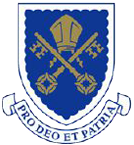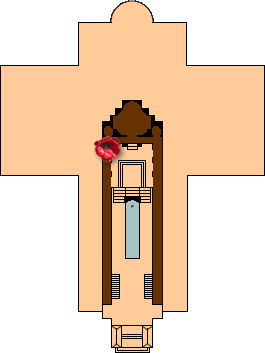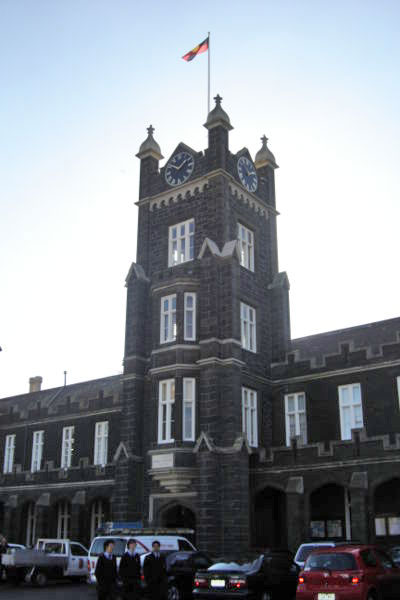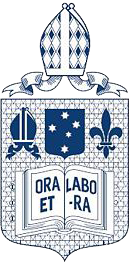Image above:
Melbourne Grammar School crest; also known as MGS or Melbourne Boys, is an independent, day and boarding school predominantly for boys', located in Melbourne, Victoria, Australia. Founded in 1858, the school is a member of the Associated Public Schools of Victoria. It is associated with the Anglican Church of Australia, and was formerly named Melbourne Church of England Grammar School. From the start it was exclusive, catering to the young gentlemen of rich immigrant English and squatter families, and originally the student body consisted only of boarders. The junior school (years prep to 6), Grimwade House, is co-educational. It is located in the suburb of Caulfield, east of Melbourne city itself, and is named after the Grimwade family, who in 1918 donated the land and house for the use of the school. The waiting list was huge - if not enrolled at birth, there was no chance of ever attending. Whilst Grimawade has long catered to students of both sexes, the Old Melburnians have resisted any moves to inroduce girls to either the middle school (Wadhurst) or the Senior School.
 |
Image above:
The Old Melburnians logo, established 1895 by Melbourne Grammar Old Boys. Well known (in Australia, at least) OMs include: Alfred Deakin and Malcolm Fraser, both former Prime Ministers, and character actor Barry Humphries, creator of Les Patterson and Dame Edna Everage.

Image above:
St Peter's College crest; an independent boy's school in the South Australian capital of Adelaide. Founded in 1847 by members of the Anglican Church of Australia, the school is noted for its famous alumni, including three Nobel laureates and forty-one Rhodes scholars. Three campuses are located on the Hackney Road site near the Adelaide Parklands in St Peters.


Refrigeration Engineer;
Lieutenant, 51st Battalion (formerly 49th Battalion) 2nd Anzac Corps
Victorian Representative Player — Victoria vs NSW, Melbourne, August 31, 1909
Victorian Representative Player — Victoria vs NSW, Sydney, 1910
Panel 153 in the Commemorative Area at the Australian War Memorial
29 The Ypres (Menin Gate) Memorial Belgium,
eastern exit of the town of Ypres, Flanders, Belgium:
'REID, Lt. Andrew Lambert, 51st Battalion, 9th June 1917, Age 27. Son of Henry Newman Reid and Lucy Reid, of 9 Blackfriars St, Sydney. Native of Melbourne.'

Born 21 Sep 1889, Hawksburn, Melbourne, Victoria,
Killed in action on 9 June 1917 at the Battle of Messines Ridge, Flanders, Belgium
Son of Henry Newman Reid and Lucy Reid (nee Marsden) of Melbourne, Victoria.
Religion: Church of England
Height 5' 7.25", chest 35-37", weight 142 pounds,
Complexion: fresh (fair), eyes brown, hair dark brown,
Mole on neck, scars: 4 left arm, left knee, top of left arm left shoulder blade.
Andrew lived at the Reid family home, 'Locksley', Haverbrack Ave Malvern
Education
Melbourne Grammar School, Domain Rd, South Yarra
• Headmaster Frederic Sergeant (1894-1898)
• Headmaster George Ernest Blanch (1899-1914)
St Peters College, Adelaide, 1904
Matriculated 1907 Physics (honours)
Senior Public 1908
Ice Hockey
August 31, 1909, Melbourne, Victoria defeated NSW 0-1, 1-0, 6-1:
Victoria: R. Jackson, A. Reid, Purbrick [9], Woods, Blair, Smith and Heywood.
NSW:- Turnbull, Cuthbert, Pike, Forsyth and Lane
1910, Sydney, Victoria defeated NSW
Victoria: R Jackson (Captain), A. Reid, Woods, Blair, Walker, [John] Goodall and MacGillicuddy. First match played by Victorian John Goodall, after whom the Goodall Trophy is named.
Military Service
1 yr Volunteer Cadets, St Peters College, Adelaide
1 yr Volunteer Cadets, Melbourne Grammar School
6 months Lieut. (prov) 48th Kooyong Infantry
Qualified, 2nd Lieutenant Examination, 5 June 1915
Civil Employment:
Refrigerating Engineer, probably employed in his fathers company, Melbourne Ice Skating & Refrigeration Co
War Service
7 months 48th Infantry, Prov. Lieutenant
Enlisted 18 Jan 1816, aged 26 yrs 5 mths, single,
Present Rank on enlistment: Sargeant 38th Inf., AIF
Unit: D Coy, 38th Battalion
Royal Park Depot, transferred to Bendigo,
Transferred from 49th Battalion to 51st Battalion, AIF, Rank 2nd Lieutenant
20/6/16 Left Australia on A54 "Runic"
19/8/16 England 10th Training Battalion
21/10/16 Proceeded to France
22/10/16 4th ADBD from England, Etaples
31/10/16 Attached to 51st Battalion, France
30/12/16 Promoted Lieutenant, France
9/6/17 Killed in Action in the Field (Messines Ridge), Belgium
Buried West of Yaer Canal, northern outskirts of Ypres, Flanders, Belgium.
Battle Honours
The 49th Battalion was raised in Egypt on 27 February 1916 as part of the “doubling” of the AIF. Approximately half of its recruits were Gallipoli veterans from the 9th Battalion, and the other half, fresh reinforcements from Australia. Reflecting the composition of the 9th, the 49th was predominantly composed of men from Queensland. The battalion became part of the 13th Brigade of the 4th Australian Division.
Arriving in France on 12 June 1916, the 49th moved into the trenches of the Western Front for the first time on 21 June. It fought in its first major battle at Mouquet Farm in August and suffered heavily, particularly in the assault launched on 3 September. The battalion saw out the rest of the year alternating between front-line duty, and training and labouring behind the line. This routine continued through the bleak winter of 1916–17.
Early in 1917, the battalion participated in the advance that followed the German retreat to the Hindenburg Line, supporting the 13th Brigade’s attack at Noreuil on 2 April. Later in the year, the focus of the AIF’s operations moved to the Ypres sector in Belgium. There the battalion fought in the battle of Messines on 9 June
War Gratuity Schedule
1914-15 Star, for service on the establishment of a unit in a theatre of war.
British War Medal No. 42632, for entry into a theatre of war on duty.
Victory Medal No 42176, for service on the establishment of a unit in a theatre of war.

Roll of Honour
Andrew Lambert Reid's name is located at panel 153 in the Commemorative Area at the Australian War Memorial (as indicated by the poppy on the plan).
 |
Sources:
[1] "The History of the Goodall Cup", author not stated, IHA, IHA website.
[2] "Ice Hockey: The NSW Ice Hockey, Association Inc. Australia - Facts and Events 1907-1999" by Sid Tange (1999). 175pp. unpublished manuscript; Extracts published in 2007 on the IHNSW website for the 2008 Centenary.
[3] 'Australian War Memorial, 1997-2007, Roll of Honour', Lt. Andrew Lambert Reid, AWM145 Roll of Honour cards, 1914-1918 War, Army, Online
[32] 'First Australian Imperial Force Personnel Dossiers, 1914-1920, Air Force Service Records, Leslie Herbert Reid: Service No. 714', National Archives of Australia, Canberra, Series No. B2455 Barcode: 8028174. 50pp, NAA Digital Image
[33] 'First Australian Imperial Force Personnel Dossiers, 1914-1920, Military Service Records, Andrew Lambert Reid: Service No. 714', National Archives of Australia, Canberra, Series No. B2455 Barcode: 8025997. 58pp, NAA Digital Image
Image below:
Witherby Tower of MGS flying the aboriginal flag for reconciliation week.
The Cordner-Eggleston Cup is competed for each year by the first football teams of Melbourne Grammar School and Scotch College. It commemorates the first recorded game of Australian Rules Football which was played between the two schools on the 7th August 1858 and was umpired by Tom Wills, one of the inventors of the code of Australian Football. The original game ran for three days and is also commemorated by a statue depicting the game outside the Melbourne Cricket Ground.
 |



